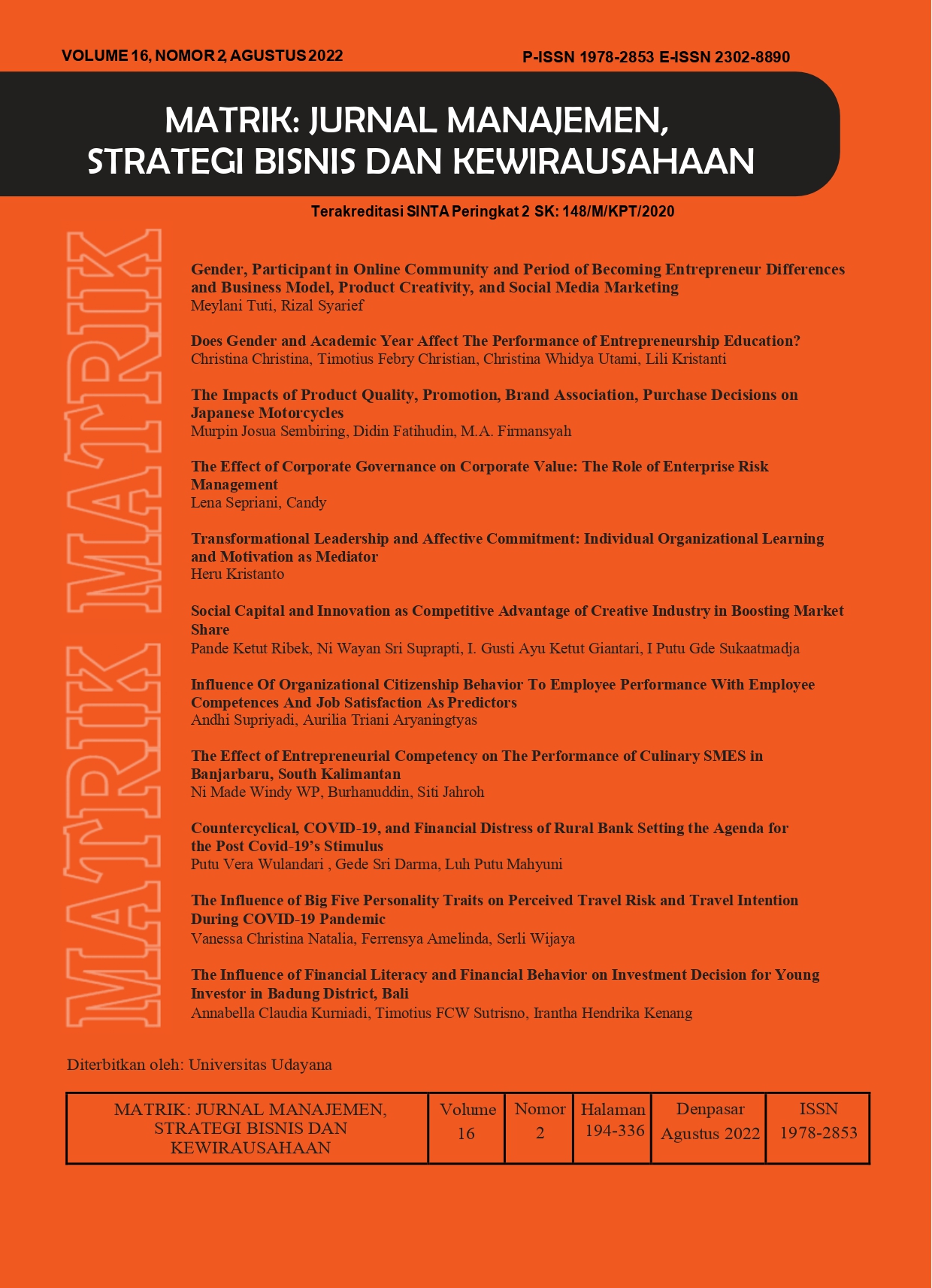The Influence of Financial Literacy and Financial Behavior on Investment Decision for Young Investor in Badung District, Bali
Abstract
Berbagai faktor yang menyebabkan meningkatnya tingkat kasus investasti fiktif disinyalir karena masyarakat yang kurang memiliki edukasi mengenai keuangan dan investasi. Tujuan dari penelitian adalah untuk mengetahui pengaruh Financial Literacy dan Financial Behavior selaku variabel independen terhadap Investment Decision selaku variabel dependen dengan Financial Behavior sekaligus sebagai variabel mediasi. Metode yang digunakan dalam penelitian ini yaitu metode analisis berupa Partial Least Square (PLS) dengan software SmartPLS. Sampel penelitian ini yaitu investor muda dalam rentang umur 18 sampai 40 tahun yang berdomisili di Kabupaten Badung, Bali sebanyak 156 responden. Teknik Purposive sampling digunakan dengan penentuan ukuran sampel menggunakan rumus Hair. Teknik pengumpulan data dalam penelitian ini yaitu membagian kuesioner secara daring dengan pengukuran skala likert. Berdasarkan analisis data, disimpulkan bahwa Financial Literacy dan Financial Behavior, berpengaruh signifikan terhadap Investment Decision. Financial Behavior tidak memberikan peran mediasi sebagai hubungan antara Financial Literacy terhadap Investment Decision. Hasil riset ini menjelaskan bahwa memang semakin tingginya tingkat Financial Literacy dan tingkat Financial Behavior seorang investor akan semakin membantu investor dalam membuat keputusan berinvestasi atau Investment Decision.
Downloads
References
Ayu Wulandari, D., & Iramani, R. (2014). Studi Experienced Regret, Risk Tolerance, Overconfidance Dan Risk Perception Pada Pengambilan Keputusan Investasi. Journal of Business and Banking, 4(1), 55. https://doi.org/10.14414/jbb.v4i1.293
Bodie, Z., Kane, A., & Marcus, A. J. (2013). Investment, 10th Edition. In McGraw Hill Education.
Chariri, A., Sektiyani, W., Nurlina, & Wulandari, R. W. (2018). Individual Characteristics, Financial Literacy and Ability in Detecting Investment Scams. 15(1), 91–114.
Chinen, K., & Endo, H. (2012). Effects of Attitude and Background on Personal Financial Ability : A Student Survey in the United States. International Journal of Management, 29(1), 33–46.
D.A.T, K. (2020). The Impact of Financial Literacy on Investment Decisions: With Special Reference to Undergraduates in Western Province, Sri Lanka. Asian Journal of Contemporary Education, 4(2), 110–126. https://doi.org/10.18488/journal.137.2020.42.110.126
Darmawan, A., Kurnia, K., & Rejeki, S. (2019). Pengetahuan Investasi, Motivasi Investasi, Literasi Keuangan Dan Lingkungan Keluarga Pengaruhnya Terhadap Minat Investasi Di Pasar Modal. Jurnal Ilmiah Akuntansi Dan Keuangan, 8(2), 44–56. https://doi.org/10.32639/jiak.v8i2.297
DM, R. (2021). Financial Literacy, Financial Behavior and Financial Attitudes Towards Investment Decisions and Firm Bankruptcy. ATESTASI : Jurnal Ilmiah Akuntansi, 4(1), 79–87. https://doi.org/10.33096/atestasi.v4i1.693
Edwin A. Locke. (1968). Toward a Theory of Task Motivation and Incentives. Organizational Behavior and Human Performance, 3(M), 157–189.
Fitriah, W. (2021). Financial Literacy and Financial Inclusion on the Financial Planning of the City of Palembang. Review of Management and Entrepreneurship, 5(1), 19–32. https://doi.org/10.37715/rme.v5i1.1629
Ghasarma, R., Putri, L., & Adam, M. (2017). International Journal of Economics and Financial Issues Financial Literacy; Strategies and Concepts in Understanding the Financial Planning With Self-Efficacy Theory and Goal Setting Theory of Motivation Approach. International Journal of Economics and Financial Issues, 7(4), 182–188. http:www.econjournals.com
Gupta, P. K. (2021). The Impact of Financial Literacy on Investment Decisions. Laxmi Book Publication.
Hair, J. F., Hult, G. T. M., Ringle, C. M., & Sarstedt, M. (2017). A Primer on Partial Least Squares Structural Equation Modeling (PLS-SEM). Thousand Oaks. Sage, 165.
Hakim, A. R. (2022). OJK: Kerugian Akibat Investasi Bodong Capai Rp 117 Triliun dalam 10 Tahun Terakhir. Liputan6.Com. Arief Rahman Hakim
Hasanuh, N. (2020). Influence of financial literacy and financial attitude on individual investment decisions. Advances in Business, Management and Entrepreneurship, 1993, 424–428. https://doi.org/10.1201/9780429295348-92
Klein, L. S., & Mandell, L. (2007). Motivation and financial literacy. Financial Services Review, 16(2), 105.
Lusardi, A. (2019). Financial literacy and the need for financial education: evidence and implications. Swiss Journal of Economics and Statistics, 155(1), 1–8. https://doi.org/10.1186/s41937-019-0027-5
Lusardi, A., & Mitchell, O. S. (2014). The economic importance of financial literacy: Theory and evidence. Journal of Economic Literature, 52(1), 5–44. https://doi.org/10.1257/jel.52.1.5
Mahastanti, L. A. (2011). Faktor-Faktor Yang Dipertimbangkan Investor Dalam Melakukan Investasi. Jurnal Manajemen Teori Dan Terapan| Journal of Theory and Applied Management, 4(3), 37–51. https://doi.org/10.20473/jmtt.v4i3.2424
Manurung, A. H. (2012). Teori Perilaku Keuangan ( Behaviour Finance ). Economis Of Management, 41(4), 1–13. http://finansialbisnis.com/Data2/Riset/Teori Perilaku Keuangan.pdf
Marsh, B. A. (2006). Knowledge Levels of First-Year and Senior Students At Baptist. August, 31–42.
Mohd Padil, H., Kasim, E. S., Muda, S., Ismail, N., & Md Zin, N. (2022). Financial literacy and awareness of investment scams among university students. Journal of Financial Crime, 29(1), 355–367. https://doi.org/10.1108/JFC-01-2021-0012
Mutiara, I., & Agustian, E. (2020). Pengaruh Financial Literacy dan Financial Behavior terhadap Keputusan Investasi pada Ibu-Ibu PKK Kota Jambi. J-MAS (Jurnal Manajemen Dan Sains), 5(2), 263. https://doi.org/10.33087/jmas.v5i2.193
Normalasari, Maslichah, & Sudaryanti, D. (2022). The Effect of Financial Behavior, Financial Literacy and Demographic Factor on Students’Investment Decision Making. Jurnal Ilmiah Riset …, 11(02), 53–61. http://riset.unisma.ac.id/index.php/jra/article/view/15073%0Ahttp://riset.unisma.ac.id/index.php/jra/article/download/15073/11268
Nur Aini, N. S., & Lutfi, L. (2019). The influence of risk perception, risk tolerance, overconfidence, and loss aversion towards investment decision making. Journal of Economics, Business & Accountancy Ventura, 21(3), 401. https://doi.org/10.14414/jebav.v21i3.1663
Organisation for Economic and Cooperation and Development. (2011). Measuring financial literacy: questionnaire and guidance notes for conducting an internationally comparable survey of financial literacy. Oecd, 31. https://www.oecd.org/finance/financial-education/49319977.pdf
Padil, H. M., Kasim, E. S., & Ismail, N. (2020). An Exploratory Factor Analysis of Financial Literacy and Awareness of An Exploratory Factor Analysis of Financial Literacy and Awareness of Investment Scam. 3(November), 61–67.
Perwito, Nugraha, & Sugianto. (2020). Efek Mediasi Perilaku Keuangan Terhadap Hubungan Antara Literasi Keuangan Dengan Keputusan Investasi. Competition: Jurnal Ilmiah Manejemen, X1(2), 155–164.
Potrich, A. C. G., Vieira, K. M., Coronel, D. A., & Bender Filho, R. (2015). Financial literacy in Southern Brazil: Modeling and invariance between genders. Journal of Behavioral and Experimental Finance, 6, 1–12. https://doi.org/10.1016/j.jbef.2015.03.002
Potrich, A. C. G., Vieira, K. M., & Mendes-Da-Silva, W. (2016). Development of a financial literacy model for university students. Management Research Review, 39(3), 356–376. https://doi.org/10.1108/MRR-06-2014-0143
Rasuma Putri, N. M. D., & Rahyuda, H. (2017). Pengaruh Tingkat Financial Literacy Dan Faktor Sosiodemografi Terhadap Perilaku Keputusan Investasi Individu. E-Jurnal Ekonomi Dan Bisnis Universitas Udayana, 9, 3407. https://doi.org/10.24843/eeb.2017.v06.i09.p09
Raut, R. K. (2020). Past behaviour, financial literacy and investment decision-making process of individual investors. International Journal of Emerging Markets, 15(6), 1243–1263. https://doi.org/10.1108/IJOEM-07-2018-0379
Remund, D. L. (2010). Financial literacy explicated: The case for a clearer definition in an increasingly complex economy. Journal of Consumer Affairs, 44(2), 276–295. https://doi.org/10.1111/j.1745-6606.2010.01169.x
Sorongan, F. A. (2022). The Influence of Behavior Financial and Financial Attitude on Investment Decisions With Financial Literature as Moderating Variable. 7(1), 265–268.
Sugiyanto, T., Radianto, W. E., Efrata, T. C., & Dewi, L. (2019). Financial Literacy, Financial Attitude, and Financial Behavior of Young Pioneering Business Entrepreneurs. 100(Icoi), 353–358. https://doi.org/10.2991/icoi-19.2019.60
Tennant, D. (2011). Why do people risk exposure to Ponzi schemes? Econometric evidence from Jamaica. Journal of International Financial Markets, Institutions and Money, 21(3), 328–346. https://doi.org/10.1016/j.intfin.2010.11.003
Upadana, I. W. Y. A., & Herawati, N. T. (2020). Pengaruh Literasi Keuangan dan Perilaku Keuangan terhadap Keputusan Investasi Mahasiswa. Jurnal Ilmiah Akuntansi Dan Humanika, 10(2), 126. https://doi.org/10.23887/jiah.v10i2.25574
 This work is licensed under a Creative Commons Attribution-ShareAlike 4.0 International License.
This work is licensed under a Creative Commons Attribution-ShareAlike 4.0 International License.

















